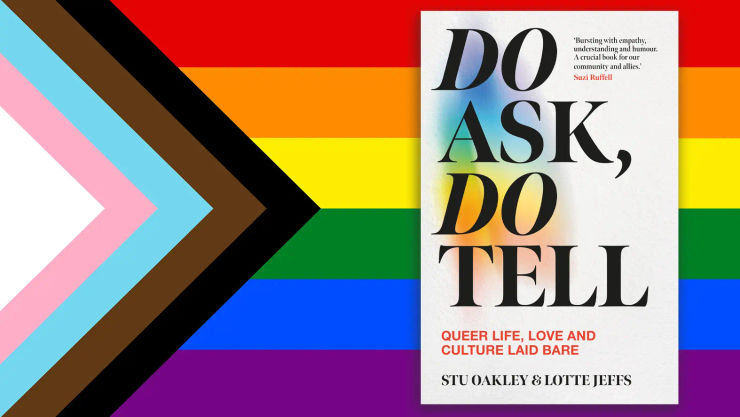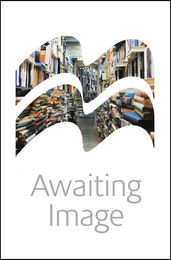Everything you ever wanted to ask about queer life (but didn’t want to get wrong)
Lotte Jeffs, author of Do Ask, Do Tell: Queer Life, Love and Culture Laid Bare answers some of the most Googled questions about LGBTQIA+ experiences.

The world of LGBTQIA+ identities can feel like an ever-expanding constellation: terms, histories, personal stories, reclaimed words, contested meanings. But you don’t need to hold the whole galaxy in your head to understand queer life or be a good ally. Queer, straight, cis and everything in-between – we all need to gain the confidence to say 'I don’t know', ask, and have the curiosity, openness, and the willingness to let people tell you who they are. This is the ethos that Lotte Jeffs and Stu Oakley brought to their new non-fiction book Do Ask, Do Tell, where you can find important insights and answers to all sorts of queries around queer life.
So what kind of things do people really want to know? We put some of the most Googled questions about the LGBTQIA+ experience to Lotte.
What does 'queer' mean?
For me, queerness is about spaciousness. It’s a way of saying: I exist outside the tidy labels you might expect. Maybe I’m not strictly lesbian or gay or bi; maybe I’m still evolving, still learning who I am. When I was a teenager in the ’90s, the landscape was narrow and you were either gay or straight, and within that, you were handed fixed roles like butch or femme, top or bottom. Bisexuals were often dismissed, told to 'pick a side.'
Now, younger generations embrace a looser, more creative spectrum. 'Queer' holds ambiguity; it leaves room for change. It’s a word I’ve started to use more for myself, because it allows me to explore my identity without feeling I’ve betrayed an old version of me. That said, it’s important to know that for some, especially older LGBTQ+ folks, 'queer' still carries the sting of insult, a word spat in the playground. So, if you’re wondering when to use it: if someone in your life claims the word, follow their lead. But if you’re at all unsure it’s easy to ask someone how they identify.
What’s the difference between bisexual and pansexual?
The honest answer is – not much! Both describe attraction to multiple genders, but where bisexuality can refer to an attraction to male and female-identified people, pansexuality explicitly emphasises attraction regardless of gender, so the gender of a person is not the defining factor. Some people use the terms interchangeably; some don’t. Either way, it’s best not to tie yourself in knots over precise definitions. Language in queer spaces is often personal and evolving. Let people tell you what fits for them.
‘Language in queer spaces is often personal and evolving. Let people tell you what fits for them.’
What does 'wlw' mean?
'Wlw' stands for 'women-loving-women.' It’s a term often used online particularly in younger digital spaces as an umbrella that includes lesbians, bisexual women, pansexual women, and anyone who identifies as a woman and is attracted to women. You could say it’s a kind of short-hand, and simply quicker to type than all the specific identities that fall under it, or you could argue that it’s a more open and inclusive term. Yet again, there’s no single right answer!
What’s a twink?
Within gay male culture, there’s a whole glossary of body-based identities. You might have heard of Bears – hairy older men often of a bigger build – but did you know ‘Otter’ is the term for a young Bear? Someone hirsute, in their twenties and typically slimmer than a Bear. A twink is also a very body-specific term, which many consider to be a problematic element of gay male culture. Twinks are typically young, slim, white, and hairless. There is no single agreed origin for this term, some think it’s an evolution of ‘twank’, which was 1920s British slang for a client of gay male prostitutes (incidentally – what a great word!). Or it could be traced to the 1910s’ use of ‘twinkle toes’, a euphemism for a gay man. Some also suggest it relates to the Twinkie – a cream-filled sweet treat that was created in the US in 1930. Of course, there are even more hyper-specific sub-categories within twink, such as ‘twunk’ – a hunky or perhaps more muscular twink.
These labels can be playful, sexy, or affirming, but they also reflect how deeply body image and age shape gay male culture. They’re worth knowing, but they’re not rules to live by.
Can you get a drag king?
Drag kings absolutely exist! While drag queens have dominated the mainstream (thanks, RuPaul), drag kings are women or non-binary performers who amplify masculinity on stage with performances that range from song and dance to comedy or even sexy/funny strip shows! Drag Kings challenge norms, expand performance, and are well worth seeking out if you’ve never seen one live. As iconic British Drag King Adam All tells us in our book, 'masculinity is very often completely misunderstood as being a neutral ground and people think of it as, oh, that’s just people being people, but as drag kings naturally prove – masculinity is just as performative as femininity.'
What does 'intersex' mean?
This is a big one and I’d urge you to read Do Ask, Do Tell for the full picture. But in brief, intersex people are born with physical, genetic, hormonal, or chromosomal traits that don’t fit typical male or female categories. This can include variations in genitalia, chromosomes, or reproductive anatomy. About 1.7% of people worldwide are intersex, a percentage roughly equivalent to people born with red hair.
It’s crucial to distinguish this from being transgender. Intersex is about physical traits; trans is about gender identity. An intersex person might identify as male, female, non-binary, or trans, or none of these, some intersex people want to be part of the queer community and others don’t, so try not to make any assumptions.
Historically, many intersex people have faced unnecessary medical interventions as children, often without their consent, to make their bodies conform to binary expectations. Listening to intersex voices, respecting the language they use, and pushing back against shame or secrecy is key to being a good ally.
Can you be trans and non-binary?
Absolutely. Being transgender means your gender identity doesn’t align with the sex you were assigned at birth. That can mean you’re a trans man or trans woman, or it can mean you identify as non-binary, genderqueer, agender, or in some other way outside the male/female binary.
‘Being transgender means your gender identity doesn’t align with the sex you were assigned at birth. That can mean you’re a trans man or trans woman, or it can mean you identify as non-binary, genderqueer, agender, or in some other way outside the male/female binary. ’
Not all non-binary people identify as trans though. It’s easy to get in a muddle about this one, we certainly were when writing the book, until writer and psychotherapist Chance Czyzselska cleared it up for us: 'Some non-binary people don’t identify as trans, and some, like me, do. We maybe use trans as a way of making it clear we are not cis. Because I don’t wholly identify with the gender I was assigned at birth, I consider myself trans, and I also personally feel trans opens up a vast landscape of gendered possibilities, like it offers less fixed/rigid possibilities/expectations and more movement. I also think that gender is relational, so we may feel that certain aspects of our gender expression are more pronounced with some people and less with others.’
What’s the difference between ENM and polyamory?
ENM, or ethical non-monogamy, is a broad term for consensual, non-exclusive relationships. Polyamory, which means having multiple loving or romantic relationships, is one form of ENM. Other forms include open relationships or relationship anarchy (sounds fun right?). The common thread is consent and honesty: all parties know, agree, and navigate the dynamics together.
What’s the A in LGBTQIA+?
The 'A' can stand for asexual (little or no sexual attraction), aromantic (little or no romantic attraction), or agender (not identifying with any gender) or you could say it stands for ‘anything else’! These identities each reflect a distinct way of moving through the world, and like all queer identities, they challenge assumptions about what’s 'normal' or expected.
We hope you’ve found some answers to the questions you had here, but there will never be one neat, finished glossary that answers every query about queer life definitively. Identities shift. Language changes. People grow. But maybe that’s the point – to stay open, to listen, and to let yourself be moved by the sheer variety of human experience.
Do Ask, Do Tell
by Lotte Jeffs, Stu Oakley
What is a black cat lesbian? Is ‘aromantic’ a sexuality or a preference? What’s it like to be queer and religious? Does Gen Z do darkrooms? How do you navigate life as a OAQ (Old Age Queer)? What does trans euphoria feel like? Why is nightlife so central to the community? What is camp today? Do Ask, Do Tell is your guide to the dazzling spectrum of queer life, answering the questions you’ve always wanted to ask, but maybe didn’t know how. Perfect for LGBTQIA+ readers and allies alike, it’s a celebration of curiosity, understanding, and the richness of queer experiences.



